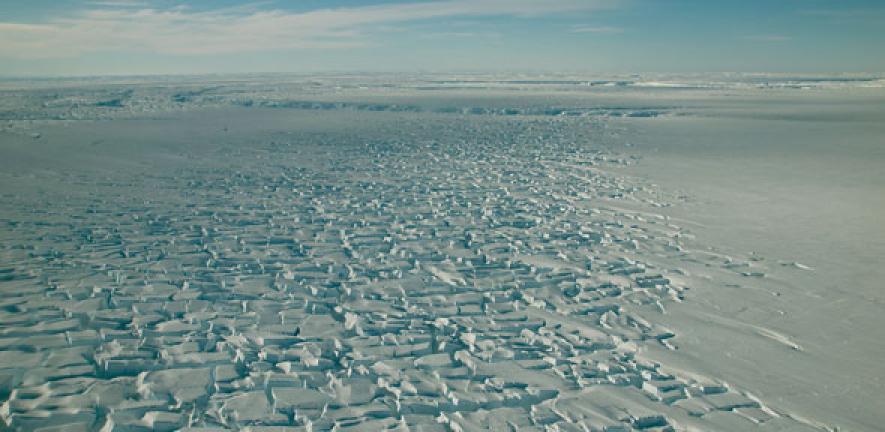
A Cambridge researcher will lead one of eight projects in a new joint UK-US research programme that is one of the most detailed and extensive examinations of a massive Antarctic glacier ever undertaken.
A Cambridge researcher will lead one of eight projects in a new joint UK-US research programme that is one of the most detailed and extensive examinations of a massive Antarctic glacier ever undertaken.
These margins have so far never been studied directly, due to the logistical challenges of working in such a remote region of Antarctica.
Poul Christoffersen
The collapse of the Thwaites Glacier in West Antarctica could significantly affect global sea levels. It already drains an area roughly the size of Britain or the US state of Florida, accounting for around four percent of global sea-level rise —an amount that has doubled since the mid-1990s.
As part of a new £20 million research collaboration, the UK Natural Environment Research Council and the US National Science Foundation will deploy scientists to gather the data needed to understand whether the glacier’s collapse could begin in the next few decades or centuries.
NERC and NSF have jointly funded eight large-scale projects that will bring together leading polar scientists in one of the most inhospitable regions of the planet. The programme, called the International Thwaites Glacier Collaboration (ITGC), is the largest joint project undertaken by the two nations in Antarctica for more than 70 years - since the conclusion of a mapping project on the Antarctic Peninsula in the late 1940s.
In addition to the £20 million-worth ($25 million) of awards to the research teams, the logistics of mounting a scientific campaign in one of the most remote places in Antarctica could cost as much again in logistical support. The nearest permanently occupied research station to the Thwaites Glacier is more than 1600km away, so getting the scientists to where they need to be will take a massive joint effort from both nations. While researchers on the ice will rely on aircraft support from UK and U.S. research stations, oceanographers and geophysicists will approach the glacier from the sea in UK and U.S. research icebreakers.
Dr Poul Christoffersen from the University of Cambridge’s Scott Polar Research Institute is co-leading one of the eight projects with Professor Slawek Tulaczyk from the University of California, Santa Cruz. Their project, Thwaites Interdisciplinary Margin Evolution (TIME) also includes researchers from the University of Leeds, Stanford University, the University of Texas and the University of Oklahoma. The team will investigate how the margins of the drainage basin will evolve and influence ice flow over the coming decades.
“These margins have so far never been studied directly, due to the logistical challenges of working in such a remote region of Antarctica,” said Christoffersen. “The margins, which separate the fast-flowing glacier from the surrounding slow-moving ice, are often thought of as being stationary, but they might not be. The hypothesis that drives our science is that they can move and thereby exert powerful control on the future evolution of ice flow in the whole drainage basin.”
“This international collaboration will lead to a step change in our understanding of ice sheet stability,” said Cambridge’s Dr Marion Bougamont, who will use observational data records gathered in the field to improve computer models needed to predict sea level rise. “The glacier’s response will depend on where the margins are and how they evolve.”
Today’s collaboration involves around 100 scientists from world-leading research institutes in both countries alongside researchers from South Korea, Germany, Sweden, New Zealand and Finland, who will contribute to the various projects. These projects aim to deliver answers to some of the big questions for scientists trying to predict global sea-level rise.
Antarctica’s glaciers contribute to sea-level rise when more ice is lost to the ocean than is replaced by snow. To fully understand the causes of changes in ice flow requires research on the ice itself, the nearby ocean, and the Antarctic climate in the region. The programme will deploy the most up-to-date instruments and techniques available, from drills that can make access holes 1,500 meters into the ice with jets of hot water to autonomous submarines like the Autosub Long Range affectionately known around the world as Boaty McBoatface.
“Rising sea levels are a globally important issue which cannot be tackled by one country alone,” said UK Science Minister, Sam Gyimah. “The Thwaites Glacier already contributes to rising sea levels and understanding its likely collapse in the coming century is vitally important. Science, research and innovation are at the heart of our Industrial Strategy and this UK-U.S. research programme will be the biggest field campaign of its type ever mounted by these countries. I’m delighted that our world-leading scientists will help to lead this work.”
The science programme and logistics on the five-year programme begins in October 2018 and continues to 2021. The funding is for eight research projects and a co-ordination grant to maximise success.
Adapted from a NERC/NSF press release.

The text in this work is licensed under a Creative Commons Attribution 4.0 International License. For image use please see separate credits above.




